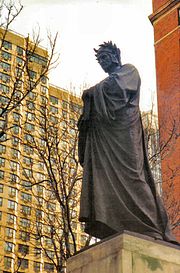웨스트 브로드웨이 브리지
West Broadway Bridge웨스트 브로드웨이 브리지 | |
|---|---|
 | |
| 좌표 | 40°55, 16°N 74°10′30″w/40.9211°N 74.1751°W좌표: 40°55°16°N 74°10°30°W / 40.9211°N 74.1751°W / |
| 들다 | 패터슨함부르크 턴파이크 웨스트 브로드웨이 군도 제509호선 CR 673 |
| 크로스 | 파사이크 강 |
| 로캘 | 뉴저지 주 |
| 기타 이름 | 웨스트 스트리트 브리지 콘크리트-금속 교량 |
| 주인 | 파세익 현 |
| 유지 보수자 | 자치주 |
| 아이디 번호 | 1600017[1] |
| 특성. | |
| 설계. | 멜란형 아치교 |
| 재료. | 강철/콘크리트 |
| 총 길이 | 290피트(88m) |
| 폭 | 35.4 피트 (10.8 m) |
| 최장 스팬 | 86.9피트(26.5m) |
| No. 스팬의 | 3 |
| 역사 | |
| 디자이너 | 에드윈 태허 |
| 공사종료 | 1897 2004년 재활 프로그램 |
| 열린 | 1897 |
| 위치 | |
 | |
| 레퍼런스 | |
| [2][3][4][5][6][7] | |
웨스트 브로드웨이 브릿지(West Street Bridge) 또는 콘크리트 금속 브릿지(Concrete-Metal Bridge)는 뉴저지주 패터슨에 있는 파세익 강 위에 있는 차량용 다리입니다.전통적으로 패터슨-햄버그 턴파이크(Paterson-Hamburg Turnpike)인 웨스트 브로드웨이(CR 673)를 운행하며, 서쪽 끝에서 카운티 509번 도로와 연결됩니다.
이 다리는 1897년에 건설되어 2004년에 복원되었다.1903년의 홍수는 패터슨 인근 대부분의 다리들의 손상이나 파괴를 야기했다; 웨스트 스트리트 다리는 심각한 [8][9]손상과 함께 살아남았다.
이 다리는 멜란 아치 교량 기술의 국가적으로 중요한 사례이자 북동부 지역에서 가장 오래되고 가장 중요한 콘크리트-철골 구간 중 하나로 여겨지고 있습니다.1991-1994년 NJDOT에 의해 실시된 역사적 교량 조사에서 이 교량이 뉴저지 사적 등록부와 국가 사적 등록부에 등재될 자격이 있는 것으로 확인되었습니다.1997년 3월 국가역사보존국은 이에 동의했다(NJRHP #3959).[10]
「 」를 참조해 주세요.

파사이크 호수와 선사시대 지역의 코스와 분수령
- 아치 스트리트 브리지
- 스트레이트 스트리트 브리지
- 파사이크 강의 건널목 목록
- 하류 파사이크 강의 건널목 목록
- 해켄삭 강의 건널목 목록
- 뉴저지 파세익 카운티의 카운티 노선 목록
- 멜란 다리
- 파세익 강 범람 터널
 트랜스포트 포털
트랜스포트 포털 엔지니어링 포털
엔지니어링 포털 뉴저지 포털
뉴저지 포털
레퍼런스
- ^ "Bridge Statistics for Paterson, New Jersey (NJ)". www.city-data.com.
- ^ "Historic Bridge Survey (1991-1994)" (PDF). NJDOT. 2001. Retrieved 14 November 2016.
The handsome, well-proportioned 233'-long, 3-span, Melan steel and concrete elliptical arch bridge has coursed brownstone ashlar-faced spandrel walls and cutwater piers. They are backed by concrete. It is 54'-wide and carries a 2-lane city street flanked by wide sidewalks enclosed by metal railings with lattice panels on the bottom. The railings were installed in 1937 replacing the original. Each of the cinder-filled arch spans is approximately 89' long, and the rise is 9.5'. The bridge is built on the Melan system with 10" I-beams set 3' on center and embedded in concrete that varies in thickness from 15" at the crown to 66" at the skewbacks. Expansion joints are built in the spandrel walls over the piers to provide for thermal changes. The southernmost two spans were damaged in the 1903 flood and were repaired in kind at that time. The bridge is well preserved...When completed in 1898, the handsome elliptical arch bridge was the second longest Melan- type bridge in the country, ranking after a similar span in Topeka, Kansas completed in 1896-97. Industrial Historian Donald C. Jackson states that the Topeka bridge, completed about one year before the similar arch at Paterson, was the "first major reinforced concrete arch bridge in the United States" (p. 35). Thacher's bridge at Paterson is one of the most important concrete-steel spans in the Northeast based on its date, structural type, and remarkably complete state of preservation (criterion C). It is a nationally significant example of the Melan arch bridge technology, and it was designed by noted civil engineer Edwin Thacher. Thacher was a proponent of the Melan arch which is a series of parallel iron or steel I-beams curved to the profile of the soffit and encased in plain concrete. Joseph Melan, a Viennese engineer, was granted an American patent for his design in 1894. Fritz von Emperger, a German-born engineer, built the first Melan arch in the United States at Rock Rapids, Iowa, and he is credited with popularizing the design in this country. Emperger made additions to the Melan system, adding a beam to the deck and joining the deck and arch beams by means of bars set on radial lines. He was granted a patent in 1897 for the changes to Melan's patent...Edwin Thacher and William Mueser formed the Concrete-Steel Engineering Company in New York City in 1901, and the firm was responsible for many important Melan-type bridges in the country, including the 8-span Grand Avenue Viaduct, Milwaukee, Wisconsin, built in 1907; a 7-span Melan arch built at Wichita, Kansas, built in 1911; the 6-span Hudson River bridge at Glens Falls, New York, built in 1914-15; the bridge over the Mississippi River at Minneapolis composed of five 231' spans built in 1907. Thacher was a versatile engineer who received many patents including one for the "Thacher Cylindrical Slide-Rule," the "Thacher Steel Bridge Truss," the "System of Concrete Steel Arches," and the "Thacher Combination Bridge Truss" among others. He held positions of chief engineer for the Decatur Bridge Company of Decatur, Alabama, and the Keystone Bridge Company of Pittsburgh before opening his own consulting firm in Louisville, Kentucky. He was responsible for the 1891 Walnut Street bridge across the Mississippi River at Chattanooga and the 1892 Costilla Crossing bridge over the Rio Grande in Colorado which was an example of the Thacher truss patented in 1884 and designed to reduce the effect of temperature stresses on truss members. Thacher formed a partnership with W.H. Keepers in 1894 at Detroit, and the partnership lasted as Thacher and Keepers until October of 1899. It was this firm that designed the West Broadway bridge at Paterson. Thacher remained with the Concrete-Steel Engineering Company until his retirement in 1912. The Melan arch was replaced in popularity in this country by the reinforced concrete arch span...The Thacher & Keepers-designed Melan-type arch bridge is one of two in the state designed by Edwin Thacher. The other is located in Branch Brook Park in Newark (Essex County) (0700101). It was designed by the Concrete-Steel Engineering Company in 1905. Both are technologically and historically important as examples of the experimentation associated with the introduction of concrete and steel arch bridges in this country.
- ^ "New Jersey and National Registers of Historic Places". NJ DEP - State Historic Preservation Office. Retrieved 28 November 2016.
- ^ "County Routes" (PDF). Passaic County.
- ^ "Passaic County Road System". Passaic County. 2001.
- ^ "West Broadway Bridge". Retrieved 26 October 2016.
- ^ Mahmoud, Khaled (2015), Sustainable Bridge Structures: Proceedings of the 8th New York City Bridge Conference, 24-25 August, 2015, New York City, USA, CRC Press, ISBN 9781315657837
- ^ Ensslin, John C. (September 2, 2011). "1903 flood still ranks as North Jersey's worst". The Record. Retrieved 14 November 2016.
- ^ Leighton, Marshall Ora (1904). "The Passaic Flood Of 1903" (PDF). Government Printing Office. p. 23. Retrieved 9 November 2016.
The bridges crossing Passaic River in Passaic, Essex, and Bergen counties were almost completely destroyed, and the damage amounted to $654,811. Within the limits of Paterson, below Great Falls, all of the highway bridges except two were either severely damaged or completely carried away. West street bridge, the first below the falls, was a Melan concrete, steel-arch structure, built in 1897, and costing $65,000. It was composed of three spans, each about 90 feet long. The flood practically split two spans longitudinally, the upstream side of each, equal to about one-third of the width of the bridge, being carried away. This structure was built to conform to the established grades of streets on both sides of the river and was completely inundated, forming a barrier for floating débris and practically making a dam in the river. Main street bridge is a 3-span, steel-arch structure, which was completely covered during the flood, but was only slightly injured. Arch street bridge, built in 1902 to take the place of a structure carried away by the March flood, was a concrete-arch bridge of three spans. It was undermined at the north pier and collapsed, being practically destroyed. The original cost of this bridge was $34,000. Its piers presented a serious obstruction to the flow of the stream, especially as the channel is very narrow at this point. In addition to this, the bridge was of low grade and admirably adapted for deterring flood flow. Below Arch street bridge all the other structures crossing the Passaic were of iron and were carried away, with the exception of Sixth avenue and Wesel bridges. Those destroyed were designated as follows: Straight street, Hillman street, Moffat, Wagaraw, Fifth avenue, East Thirty-third street, and Broadway bridges. All these structures were built too low, and were inundated during the early stages of the flood.
- ^ Zamiskie, G.; Chiara, J. (2015). "Rehabilitation of the West Broadway Bridge over the Passaic River, Paterson, New Jersey". Sustainable Bridge Structures. pp. 315–328. doi:10.1201/b18775-36. ISBN 978-1-138-02878-4.



